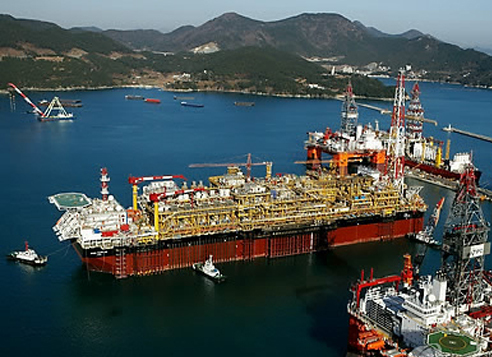South Korea’s finance regulator and state-owned creditors of the troubled Daewoo Shipbuilding & Marine Engineering unveiled Thursday an additional 2.9 trillion won ($2.6 billion) rescue plan that depends on whether all stakeholders agree to share the burden of a debt-to-equity swap.
The main creditors Korean Development Bank and Export-Import Bank of Korea suggested the additional rescue plan less than two years after a 4.2 trillion won package was decided on in October 2015, reversing an earlier promise not to pour additional funds into the company.
 |
Maritime facilities built by Daewoo Shipbuilding and Marine Egineering (Yonhap) |
“Despite self-rescue efforts by the company, reduced orders amid an industry-wide recession, weak oil prices and a delay in the delivery of drill ships have resulted in liquidity risks,” said Lee Dong-geol, CEO of Korea Development Bank, the biggest shareholder of DSME.
He warned that the shipbuilder may face bankruptcy in April unless special measures are taken.
Cash-strapped Daewoo Shipbuilding faces a deadline to refinance or pay off a total of 940 billion won worth of debts this year including 440 billion won maturing on April 21. Another 550 billion won worth of debts will mature next year.
The Financial Service Commission, KDB and Eximbank said additional liquidity worth 2.9 trillion won will be provided only if all stakeholders including commercial banks, private bondholders and the labor union agree on the painful debt restructuring plan.
“A new set of capital will be injected only if all stakeholders -- policy lenders, private creditors, the company and the labor union -- agree to fully share the burden,” Yim Jong-yong, chairman of the FSC told reporters Thursday.
Earlier Thursday, Finance Minister Yoo Il-ho also urged all interested parties to shoulder the burden.
The additional rescue package requires creditors to swap debt to equity or extend bond maturity up to five years as a precondition for the injection of new funds. Two policy lenders will swap 100 percent or 1.6 trillion won worth of debts for new shares in the shipbuilder, while private banks and bondholders will convert up to 80 percent of debts of 2.2 trillion won to equity. The plan also includes a grace period for unsecured loans up to five years.
The new plan also calls for the labor union to maintain a no-strike principle and involves a cut in the workforce by 10 percent and salaries by 20 percent.
Despite maintaining the world’s largest order backlogs, the company has been suffering from diminished orders, receiving only 10 percent of the estimated new orders in 2016.
The shipbuilder recorded an operating loss of 1.61 trillion won in 2016 following an operating loss of 2.94 trillion won in 2015, hurt by loss-making offshore plants.
The company will have to reduce its insolvent offshore plant businesses, with creditors asking the company to focus on areas such as environmental-friendly LNG carriers in which the company has the world’s best technology.
The new set of rescue plans would provide two years of a lifeline to the company after which the creditors plans to find a merger and acquisition deal to privatize the shipbuilder, nearly four-fifths of which are owned by KDB , the regulator and creditors said.
If negotiations fail, the shipbuilder will be put under a prepacked plan, a combination of a workout and court protection under which a restructure plan is agreed in advance of a company declaring its insolvency.
The financial regulator said private creditors will have a meeting to discuss the new rescue plan in April.
The government and creditors admitted Thursday that they had failed to predict a protracted recession in the shipbuilding industry and said they regretted that they have to reverse their earlier promises.
The financial regulator and the main creditors said they have decided to provide additional liquidity based on an estimated damage of as much as 59 trillion won to the country and the shipbuilding industry if the company goes bankrupt.
By Park Ga-young (
gypark@heraldcorp.com)








![[Today’s K-pop] Blackpink’s Jennie, Lisa invited to Coachella as solo acts](http://res.heraldm.com/phpwas/restmb_idxmake.php?idx=644&simg=/content/image/2024/11/21/20241121050099_0.jpg)